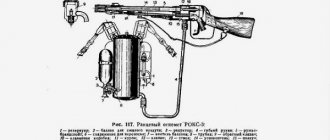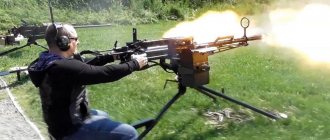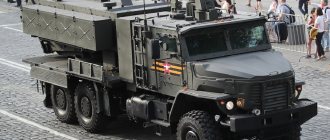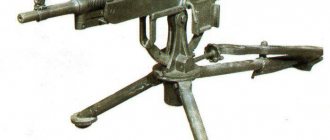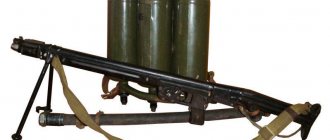| Flammenwerfer 35 | |
| |
| Type: | backpack flamethrower |
| A country: | Germany |
| Service history | |
| Years of operation: | 1935 — 1945 |
| In service: | Wehrmacht, SS troops |
| Wars and conflicts: | The Second World War |
| Production history | |
| Designed by: | 1934 |
| Years of production: | 1934 — 1940 |
| Characteristics | |
| Weight, kg: | 36 |
| Crew (crew), people: | 1 |
| Sighting range, m: | 30 |
| Maximum range, m: | 40 |
| Type of ammunition: | 1 fuel cylinder 1 gas cylinder (nitrogen) |
| Aim: | No |
Flammenwerfer 35Flammenwerfer 35
Flammenwerfer 35
(FmW.35) is a German portable backpack flamethrower of the 1934 model, adopted for service in 1935 (in Soviet sources - “Flammenwerfer 34”).
Unlike the bulky backpack flamethrowers previously in service with the Reichswehr, which were serviced by a crew of two or three specially trained soldiers, the Flammenwerfer 35 flamethrower, whose loaded weight did not exceed 36 kg, could be carried and used by just one person.
Operating principle
To use the weapon, the flamethrower, pointing the fire hose towards the target, turned on the igniter located at the end of the barrel, opened the nitrogen supply valve, and then the supply of the combustible mixture.
Having passed through the fire hose, the flammable mixture, pushed out by the force of compressed gas, ignited and reached a target located at a distance of up to 45 m.
Electric ignition, first used in the design of a flamethrower, made it possible to arbitrarily regulate the duration of shots and made it possible to fire about 35 shots. The duration of operation with continuous supply of a combustible mixture was 45 seconds.
Infantry flamethrowers | Germany
Flammenwerfer 35 backpack flamethrower
The FmW-35 portable backpack flamethrower was produced in 1935-1940. It consisted of a machine (tubular frame) with two shoulder straps, to which two metal tanks were vertically attached: the large one contained the Flammöl No. 19 combustible mixture, and the small one, located to the left of it, contained compressed nitrogen. The large tank was connected by a flexible reinforced hose to a fire hose, and the small tank was connected to the large one by a hose with a valve. The flamethrower had electric ignition, which made it possible to arbitrarily regulate the duration of the shots. To use the weapon, the flamethrower, pointing the fire hose towards the target, turned on the igniter located at the end of the barrel, opened the nitrogen supply valve, and then the supply of the combustible mixture. The flamethrower could be used by one person, but the crew included 1 - 2 infantrymen who covered the flamethrower. A total of 1,200 units were produced. Performance characteristics of the flamethrower: fire mixture tank capacity – 11.8 l; number of shots – 35; maximum operating time – 45 s; jet range – 45 m; curb weight – 36 kg.
Backpack flamethrower Klein flammenwerfer (Kl.Fm.W)
The backpack flamethrower Klein flammenwerfer (Kl.Fm.W) or Flammenwerfer 40 klein was produced in 1940-1941. It worked on the principle of FmW.35, but had less volume and weight. The small flamethrower tank was located inside the large one. Performance characteristics of the flamethrower: fire mixture tank capacity – 7.5 l; jet range – 25 – 30 m; curb weight - 21.8 kg.
Flammenwerfer 41 flamethrower
Backpack flamethrower Flammenwerfer 41 (FmW.41)
Backpack flamethrower Flammenwerfer 43 (FmW.43)
The flamethrower was produced in 1942-1945. and was the most widespread during the war. It consisted of a special machine with two shoulder belts, a large tank for fire mixture, a small tank with compressed gas, a special fire nozzle and an ignition device. The large and small reservoirs were located horizontally at the bottom of a trapezoidal semi-rigid canvas knapsack-type loom on a lightweight welded frame. This arrangement reduced the silhouette of the flamethrower, thereby reducing the likelihood of the enemy hitting the tank with the fire mixture. To eliminate misfires when igniting the fire mixture in winter, at the end of 1942 the ignition device in the flamethrower was replaced with a jet squib. The upgraded flamethrower was designated Flammenwerfer mit Strahlpatrone 41 (FmWS.41). Now its ammunition included a special pouch with 10 squibs. The weight was reduced to 18 kg, and the volume of the mixture to 7 liters.
A total of 64.3 thousand flamethrowers of both modifications were produced. Flamethrower performance characteristics: curb weight – 22 kg; fire mixture tank capacity – 7.5 l; nitrogen tank capacity – 3 l; jet range – 25 – 30 m; maximum operating time – 10 s.
As a result of further improvement of the design, the Flammenwerfer mit Strahlpatrone 41 flamethrower became the basis for subsequent work on the creation of new backpack flamethrowers - Flammenwerfer 43 (with a fire mixture volume of 9 liters and a firing range of 40 meters, weighing 24 kg) and Flammenwerfer 44 (with a fire mixture volume of 4 liters and a firing range of 28 meters, weighing 12 kg). However, the production of such flamethrowers was limited to only small-scale batches.
Flamethrower Einstoss-Flammenwerfer 46 (Einstossflammenwerfer)
In 1944, the Einstoss-Flammenwerfer 46 (Einstossflammenwerfer) disposable flamethrower was developed for parachute units. The flamethrower was capable of firing one half-second shot. They were also armed with infantry units and Volkssturm. In army units it was designated as "Volksflammerwerfer 46" or "Abwehrflammenwerfer 46". Performance characteristics: weight of equipped flamethrower - 3.6 kg; fire mixture tank volume - 1.7 l; jet range - 27 m; length - 0.6 m; diameter - 70 mm. In 1944-1945 30.7 thousand flamethrowers were fired.
Medium flamethrower Mittlerer Flammenwerfer
The medium flamethrower "Mittlerer Flammenwerfer" was in service with the Wehrmacht sapper units. The flamethrower was moved by crew forces. Flamethrower performance characteristics: weight – 102 kg; fire mixture tank volume – 30 l; maximum operating time – 25 s; jet range – 25-30 m; calculation – 2 people.
Flammenwerfer Anhanger heavy flamethrower
The Flammenwerfer Anhanger flamethrower was powered by a pump driven by an engine, which was located on the chassis along with the flamethrower. Flamethrower performance characteristics: loaded weight – 408 kg; fire mixture tank volume – 150 l; maximum operating time – 24 s; jet range – 40-50 m.
High explosive flamethrower Abwehr Flammenwerfer 42
The disposable, defensive flamethrower Abwehr Flammenwerfer 42 (A.Fm.W. 42) was developed on the basis of the Soviet high-explosive flamethrower FOG-1.
For use, it was buried in the ground, leaving a disguised nozzle pipe on the surface. The device was triggered either by remote control or by contact with a tripwire. A total of 50 thousand units were produced. Performance characteristics of the flamethrower: fire mixture volume – 29 l; affected area - a strip 30 m long, 15 m wide; maximum operating time – 3 s. Share to:
Combat use
Flamethrowers were in service with sapper units: each company had three Flammenwerfer 35 backpack flamethrowers, which could be combined into small flamethrower squads used as part of assault groups.
Despite the possibility of using a flamethrower by one person, in battle he was always accompanied by one or two infantrymen who covered the actions of the flamethrower with small arms, giving him the opportunity to quietly approach the target at a distance of 25-30 m.
The initial stage of World War II revealed a number of shortcomings that significantly reduced the possibility of using this effective weapon. The main one (besides the fact that a flamethrower that appeared on the battlefield became the primary target of enemy snipers and shooters) was the rather significant mass of the flamethrower, which reduced maneuverability and increased the vulnerability of infantry units armed with it.
As a solution to this problem, since 1940 the FmW.35 model was replaced by the lightweight Flammenwerfer 40 klein (German klein - small
) with a reduced volume of the combustible mixture and the placement of a small (gas) tank inside a large one, and in 1942 - Flammenwerfer 41 with a horizontal arrangement of tanks. However, the Flammenwerfer 35 samples that were already in service with the troops were not withdrawn from service and also continued to be used.
German flamethrower Flammenwerfer 35 (FmW.35)
The German flamethrower Flammenwerfer 35 (FmW.35)
is a portable backpack flamethrower from the Second World War, model 1934, adopted by Wehrmacht infantry units in 1935 (in USSR documents, for some unknown reason, it is indicated as “Flammenwerfer 34”).
Although the Reichswehr previously had flamethrower units in service, they had several bulky, heavy and unreliable backpack flamethrowers, consisting of relatively large maintenance crews of two, and sometimes more specially trained soldiers, the new Flammenwerfer flamethrower, manufactured in 1935, with full weight when loaded, it weighed no more than 36 kg, could be carried, maintained and used in battle by just one person and a desirable short stature.
Design of the Flammenwerfer backpack flamethrower.
The flamethrower, in its design, consisted of a separate machine (a specially curved tubular frame) with a pair of wide shoulder straps, to which two metal cylinders of different sizes were vertically attached by welding and fastening brackets. On the right side there was a large container for storing 11.8 liters of a combustible mixture called “Flammöl Nr.19”, and a small tank was placed to the left of it - it contained nitrogen compressed under high pressure, which is an inert gas and is absolutely ideal for such tasks. The large tank was connected by a special flexible reinforced hose to a guide fire nozzle equipped with a glow igniter running from an electric battery, and the small tank was connected to a large tank by means of a connecting hose with a valve.
Operating principle.
To use the weapon in combat, the flamethrower soldier, pointing the fire hose in the direction of the target, turned on the igniter located at the end of the barrel, quickly unscrewed the nitrogen supply valve, and then turned on the supply of the combustible mixture. Quickly emerging from the fire hose, pushed out by the energy of the compressed gas, the flammable mixture was automatically ignited by the igniter and quickly reached the target, hitting it with fire at a distance of up to 45 meters.
The electrical method of igniting a combustible mixture, first used by German designers in the flamethrower ignition system, gave the soldier the opportunity to independently regulate the duration and tempo of shots and thus he could fire 35-40 shots. If there was a need, the duration of continuous fire with a constant supply of combustible mixture and an aiming range of 30 meters could last approximately 45 seconds and the fire could cover large surfaces. Combat use of backpack flamethrowers.
Flamethrowers were usually in service and service of sapper units: each separate sapper company in the state consisted of three Flammenwerfer 35, which, depending on the situation and combat missions, could be combined into larger groups of flamethrower squads, taking direct part in the infantry assault groups formations. Although the crew of the flamethrower consisted of one soldier, in a real battle it was covered by fire and observation of the terrain and situation by one or more soldiers, giving the flamethrower the opportunity to covertly approach the target and hit it for sure from a distance of 25-30 m. The very first experience of WWII combat and the Second World War revealed a long series of shortcomings that significantly reduced the possibilities of using this formidable weapon. The main one was the danger of destruction of the flamethrower himself, and the great weight of this type of weapon, which reduced the mobility and mobility of groups and thereby increased the vulnerability of infantry groups armed with it.
The solution to this problem, not completely, but at least partially, was the lightweight, smaller Flammenwerfer 40 klein (from German klein translated from German - small) adopted for combat use in 1940 to replace the outdated FmW.35 with a reduced weight of the combustible mixture, its dimensions and by placing a gas tank in the middle of a large one, and in 1942 the Flammenwerfer 41 appeared, a characteristic feature of which was the horizontal arrangement of the tanks. However, the Flamenwerfer 35 samples already in service with the army were not withdrawn from service and, accordingly, continued to be used by the infantry for their intended purpose.
Links
Rifles, carbines, machine guns Gewehr 1888 • Mauser 98 • Mauser 98k • Walther SK-39 • Gewehr 41 • FG-42 • MKb.42(W) • M30 Luftwaffe • SDK • Grossfuss Sturmgewehr • Gewehr 43/Karabiner 43 • HIW VSK • StG-44 • StG45 (M) • Knorr-Bremse • VK-98 • Volkssturmgewehr 1-5 • Wimmersperg Spz • Erma Volkssturmgewehr • Vollmer M-35 • Volkssturm-Mehrladegewehr Submachine guns MP-18/MP-28 • MP-34 • MP-35 • MP-36III • MP-38/40/41 • EMP-35 • MP3008 “Volks MP” Machine guns MG 08 • MG-08/15 • MG 13 • MG 34 • MG 39 Rh • MG 42 • MG 45 • VMG 1927 • Barnitzke • BSW Modell 1 • MG-81 • FWA Hobart Anti-tank weapons Grenade launchers Faustpatrone • Panzerfaust • Panzerschreck • 8.8 cm Raketenwerfer 43 “Pupchen” • Schiessbecher • Kampfpistole Anti-aircraft grenade launchers Fliegerfaust • Luftfaust-A • Luftfaust-B Mortars Granatwerfer 36 • 8-cm sGW34 • KZ 8 cm GrW 42 • 10 cm Nebelwerfer 35 • Granatwerfer 42 Flamethrowers Flammenwerfer 35 • Abwehrflammenwerfer 42 • Einstossflammenwerfer 46 Foreign weapons Rifles Vz.24/G24(t) • Gewehr 242(f) • Gewehr 306/Karabiner 561(g) • Gewehr 98(ö)/Gewehr 306/Karabiner 505(i) • Gewehr 249(a) • Winchester Model 1895 • Gewehr 301(f) • Selbstladekarabiner 455(a) • G289(j) • Gewehr 241(f) Submachine guns MP.34(ö) • MP.722(f) • MP.746(d) • MP.716(r) • MP.715(r) • MP.717(r) • MP.41(r) • MP .719(r) • MP.739(i) • MP.738(i) • MP.761(f) • MP.769 • SS-42 Machine guns MG26(t) • MG 07/12(ö) • MG30(t) • MG 099(i) • MG-126(b)/MG-147(j)/MG-156(f) • MG 157(f) • schwere MG 200(i) • MG 216(r) • 7.7mm sMG 230(e) • MG.105(f)/MG.201(n)/MG.257(f)/MG.257(p) • leicht MG 28(p) • MG35/36A Anti-tank rifles Solothurn S18-100 • Panzerbüchse 35(p) • PzB M.SS.41 Hand grenades Stielhandgranate • Eihandgranate • HL-Handgranate • Volkshandgranate • Panzerwurfmine • Nipolit • Glasgranate • Hafthohlladung Ammo 7.65x17mm • 7.63x25mm Mauser • 7.92x33mm • 7.65x21mm Parabellum • 7.92x57mm • 9x19mm Parabellum
Excerpt characterizing Flammenwerfer 35
Lopukhin and the old general occasionally took part in the conversation. Prince Nikolai Andreich listened as the chief judge listened to the report that was being made to him, only occasionally declaring in silence or a short word that he was taking note of what was being reported to him. The tone of the conversation was such that it was clear that no one approved of what was being done in the political world. They talked about events that obviously confirmed that everything was going from bad to worse; but in every story and judgment it was striking how the narrator stopped or was stopped every time at the border where the judgment could relate to the person of the sovereign emperor. During dinner, the conversation turned to the latest political news, about Napoleon's seizure of the possessions of the Duke of Oldenburg and about the Russian note hostile to Napoleon, sent to all European courts. “Bonaparte treats Europe like a pirate on a conquered ship,” said Count Rostopchin, repeating a phrase he had already spoken several times. - You are only surprised at the long-suffering or blindness of sovereigns. Now it comes to the Pope, and Bonaparte no longer hesitates to overthrow the head of the Catholic religion, and everyone is silent! One of our sovereigns protested against the seizure of the possessions of the Duke of Oldenburg. And then...” Count Rostopchin fell silent, feeling that he was standing at the point where it was no longer possible to judge. “They offered other possessions instead of the Duchy of Oldenburg,” said Prince Nikolai Andreich. “Just as I resettled men from Bald Mountains to Bogucharovo and Ryazan, so he did the dukes.” “Le duc d'Oldenbourg supporte son malheur avec une force de caractere et une resignation admirable, [The Duke of Oldenburg bears his misfortune with remarkable willpower and submission to fate," said Boris, respectfully entering into the conversation. He said this because, while passing from St. Petersburg, he had the honor of introducing himself to the Duke. Prince Nikolai Andreich looked at the young man as if he wanted to say something to him about this, but decided against it, considering him too young for that. “I read our protest about the Oldenburg case and was surprised at the poor wording of this note,” said Count Rostopchin, in the careless tone of a man judging a case well known to him. Pierre looked at Rostopchin with naive surprise, not understanding why he was bothered by the poor edition of the note. – Doesn’t it matter how the note is written, Count? - he said, - if its content is strong. “Mon cher, avec nos 500 mille hommes de troupes, il serait facile d'avoir un beau style, [My dear, with our 500 thousand troops it seems easy to express ourselves in a good style,” said Count Rostopchin. Pierre understood why Count Rostopchin was worried about the edition of the note. “It seems that the scribblers are pretty busy,” said the old prince: “they write everything there in St. Petersburg, not just notes, but they write new laws all the time.” My Andryusha wrote a whole lot of laws for Russia there. Nowadays they write everything! - And he laughed unnaturally. The conversation fell silent for a minute; The old general drew attention to himself by clearing his throat. – Did you deign to hear about the latest event at the show in St. Petersburg? How the new French envoy showed himself! - What? Yes, I heard something; he said something awkwardly in front of His Majesty. “His Majesty drew his attention to the grenadier division and the ceremonial march,” continued the general, “and it was as if the envoy did not pay any attention and seemed to allow himself to say that in France we do not pay attention to such trifles.” The Emperor did not deign to say anything. At the next review, they say, the sovereign never deigned to address him. Everyone fell silent: no judgment could be expressed on this fact, which related personally to the sovereign. - Daring! - said the prince. – Do you know Metivier? I drove him away from me today. He was here, they let me in, no matter how much I asked not to let anyone in,” said the prince, looking angrily at his daughter. And he told his whole conversation with the French doctor and the reasons why he was convinced that Metivier was a spy. Although these reasons were very insufficient and unclear, no one objected.
